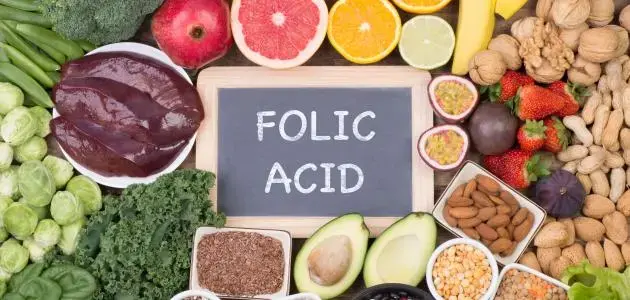Folic acid—also known as vitamin B9—is super important for making new cells in your body. It also helps break down an amino acid called homocysteine, which, if it builds up, can increase your risk for heart disease and nervous system issues.
Folic acid is part of the B-vitamin family and is water-soluble, meaning your body doesn’t store it, so you need to get some every day from your diet. It’s naturally found in small amounts in a lot of foods.
Folic Acid vs. Folate
Quick heads-up: folate and folic acid aren’t the same. Folate is the natural form you get from foods, and your body activates it during digestion. Folic acid, on the other hand, is the synthetic version found in supplements and fortified foods like cereal and flour. Unlike folate, folic acid gets activated in the liver, and that process isn’t super efficient for everyone, which means unprocessed folic acid might build up in your blood and cause problems.
Where to Find Folic Acid in Food
You’ll find folate in lots of foods like:
- Leafy greens – Spinach, kale, and other greens are top sources.
- Fortified foods – Like enriched bread, pasta, and breakfast cereals. Just watch the sugar in some cereals.
- Cooked lentils – High in folate, plus fiber, iron, and complex carbs.
- Broccoli – Full of folate, vitamin C, calcium, iron, and fiber.
- Asparagus – Low in calories, high in folate and other nutrients.
- White beans – Packed with protein, potassium, calcium, and fiber.
- Cantaloupe – Loaded with folate and vitamins A and C.
- Citrus fruits – Oranges, lemons, grapefruits are all folate-rich.
- Okra & cauliflower – Both contain a good amount of folate and vitamin C.
- Seeds and nuts – Sunflower seeds, flaxseeds, peanuts, almonds, and walnuts.
- Corn & chickpeas – Great plant-based sources of folate.
- Tropical fruits – Like bananas, mangoes, kiwis, avocados, papayas, and pomegranates.
- Liver & eggs – Rich in folate and many other vitamins.
- Beets – Great for folate, plus they add color to your plate.
- Wheat germ – A folate-rich food, but it’s often removed during flour processing.
How Much Folic Acid Do You Need?
Here’s a quick look at daily recommended intakes by age group (in micrograms):
- 0–6 months: 65 mcg
- 7–12 months: 80 mcg
- 1–3 years: 150 mcg
- 4–8 years: 200 mcg
- 9–13 years: 300 mcg
- 14+ years: 400 mcg
- Pregnant women: 600 mcg
- Breastfeeding women: 500 mcg
What Folic Acid Does for Your Body
Getting enough folic acid helps with:
- Using amino acids (the building blocks of proteins)
- Producing DNA and genetic material
- Making red blood cells in your bone marrow
- Helping cells grow—especially during childhood, adolescence, and pregnancy
- Managing homocysteine levels (with help from vitamins B6 and B12)
- Normal tissue development during pregnancy
- Supporting immune system function
Benefits of Folic Acid (Backed by Science)
Definitely Helpful
- Fixes folic acid deficiency
- Lowers high homocysteine levels – especially when combined with vitamin B12
- Reduces side effects from methotrexate – a drug used for rheumatoid arthritis
- Prevents neural tube defects – in developing babies if taken before and during early pregnancy
Possibly Helpful
- May reduce age-related vision loss
- May ease depression symptoms – when combined with antidepressants
- May help lower high blood pressure
- Could reduce stroke risk – especially in places where foods aren’t fortified
- Might improve vitiligo symptoms
Probably Not That Helpful
- Iron-deficiency anemia in pregnancy – folic acid doesn’t add extra benefit
- Boosting brain skills
- Preventing heart disease or cataracts
- Preventing childhood leukemia
- Preventing stillbirth or early labor
Not Enough Proof Yet
- Autism prevention – studies are mixed
- Slowing down chronic kidney disease
- Seizure control – limited data in kids
- Preventing age-related hearing loss
- Preventing cleft lip
- Lowering the risk of heart defects in newborns
- Helping increase baby’s birth weight
- Possibly reducing preeclampsia risk
Folic Acid Deficiency
Why It Happens
- Pregnancy (higher demand)
- Digestive issues or surgeries that affect absorption
- Certain meds that interfere with folate absorption
- Genetics – some people can’t activate folate well (MTHFR gene variants)
- Smoking or alcohol use
Symptoms of Deficiency
- Fatigue and weakness
- Gray hair
- Mouth or tongue sores
- Swollen tongue
- Development issues in kids
- Headaches or trouble focusing
Complications
Deficiency can lead to serious birth defects, a type of anemia (megaloblastic anemia), and slower oxygen delivery to organs. It may also cause developmental problems during pregnancy.
How It’s Diagnosed and Treated
Doctors use blood tests (not just symptoms) to confirm it. Treatment usually involves eating more folate-rich foods and sometimes taking supplements. People with MTHFR gene variants might need a special type of supplement called methylfolate.
Too Much Folic Acid?
It's pretty rare to get too much from food, but high-dose supplements (over 1,000 mcg a day) can be harmful. They may hide signs of vitamin B12 deficiency, which can lead to nerve damage if left untreated.
Safe Upper Limits
- 1–3 years: 300 mcg
- 4–8 years: 400 mcg
- 9–13 years: 600 mcg
- 14–18 years: 800 mcg
- 19+ years: 1000 mcg
When to Take Folic Acid Supplements
It’s best to get folate from food, but supplements can be helpful—especially for pregnant women, new moms, or people with poor diets or absorption issues. Most people tolerate them well, but some may experience:
Possible
Leave a comment
Your email address will not be published. Required fields are marked *




